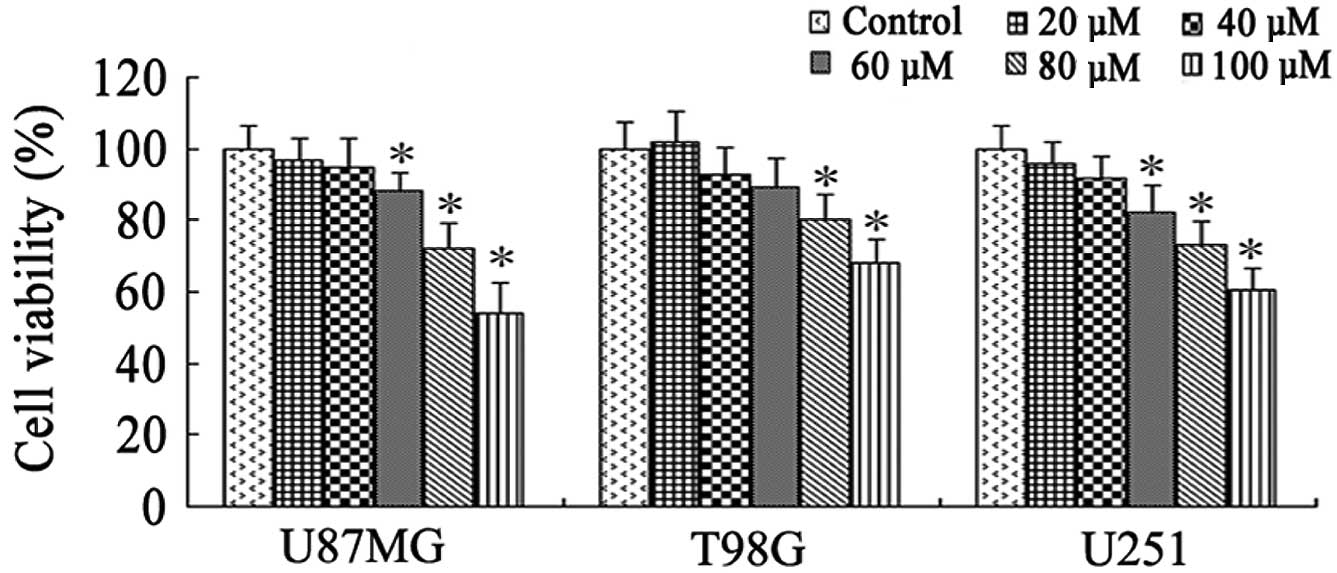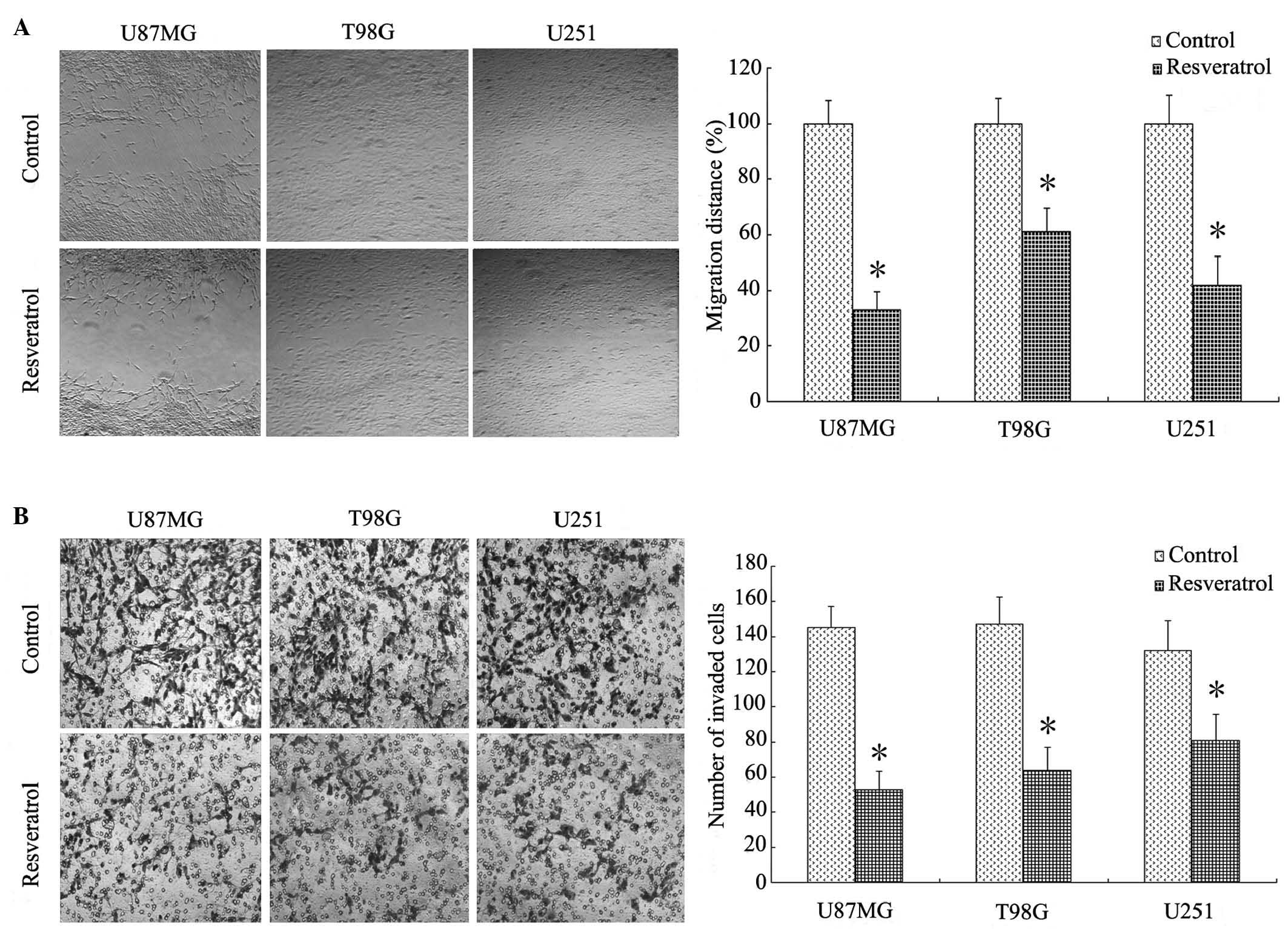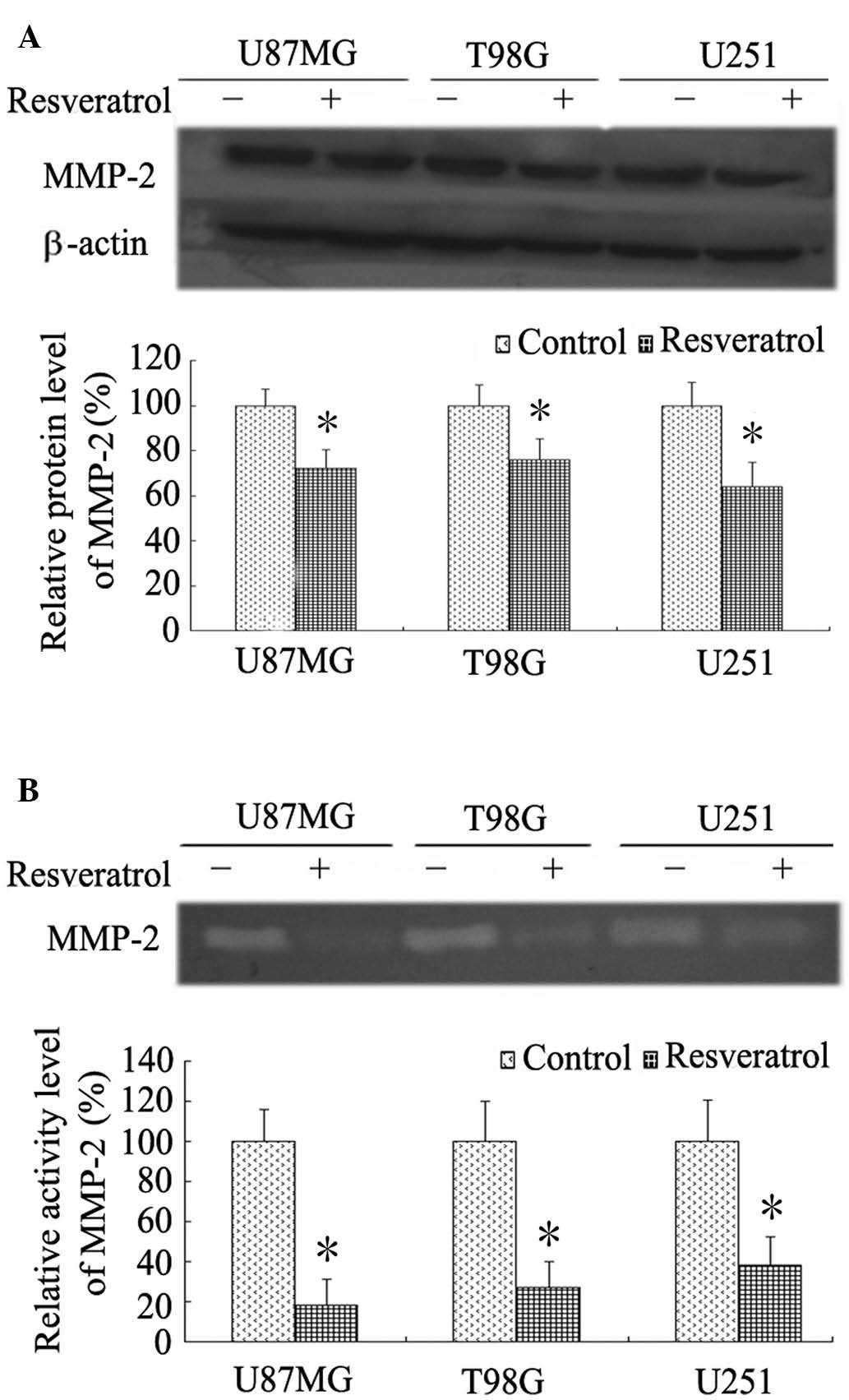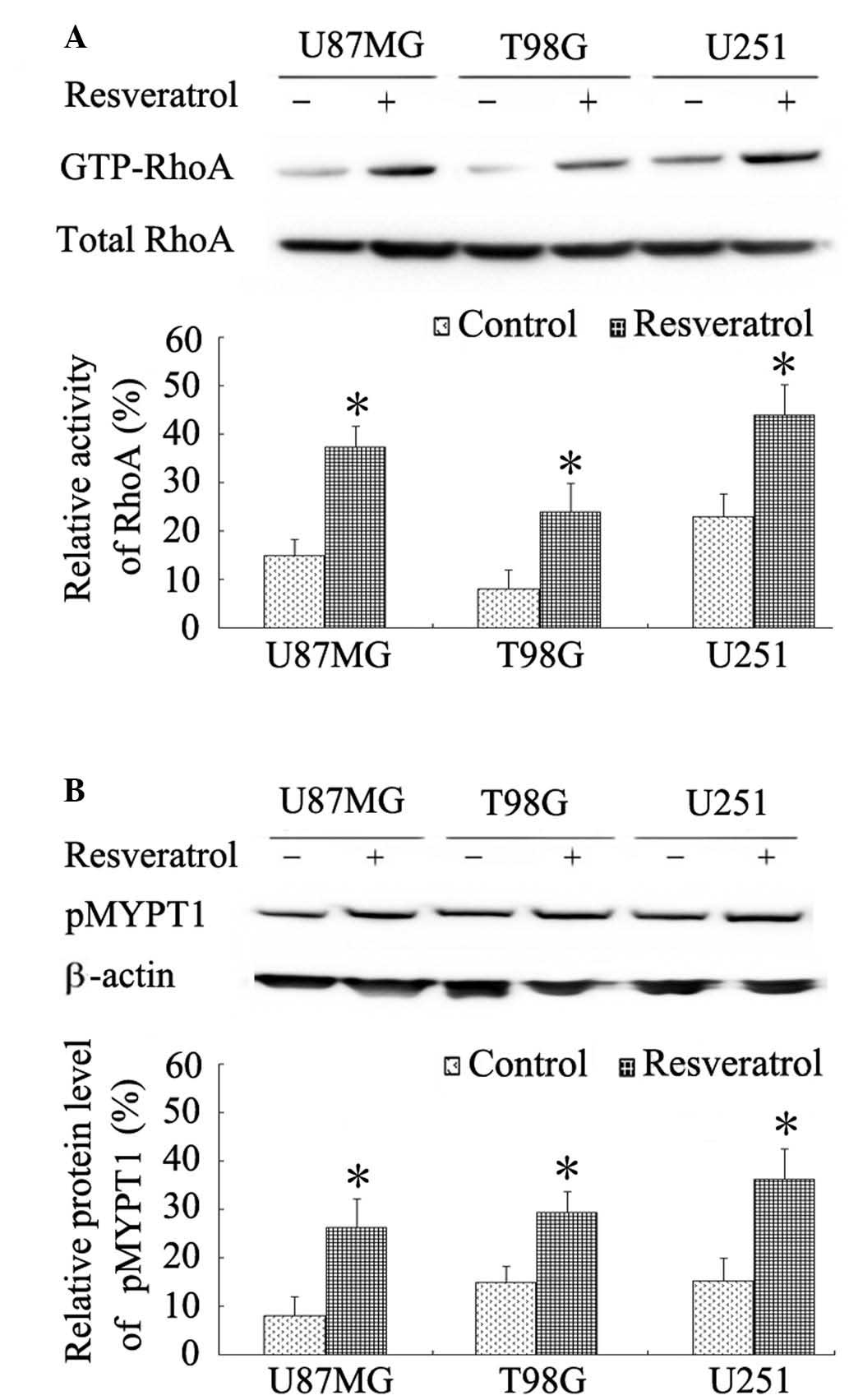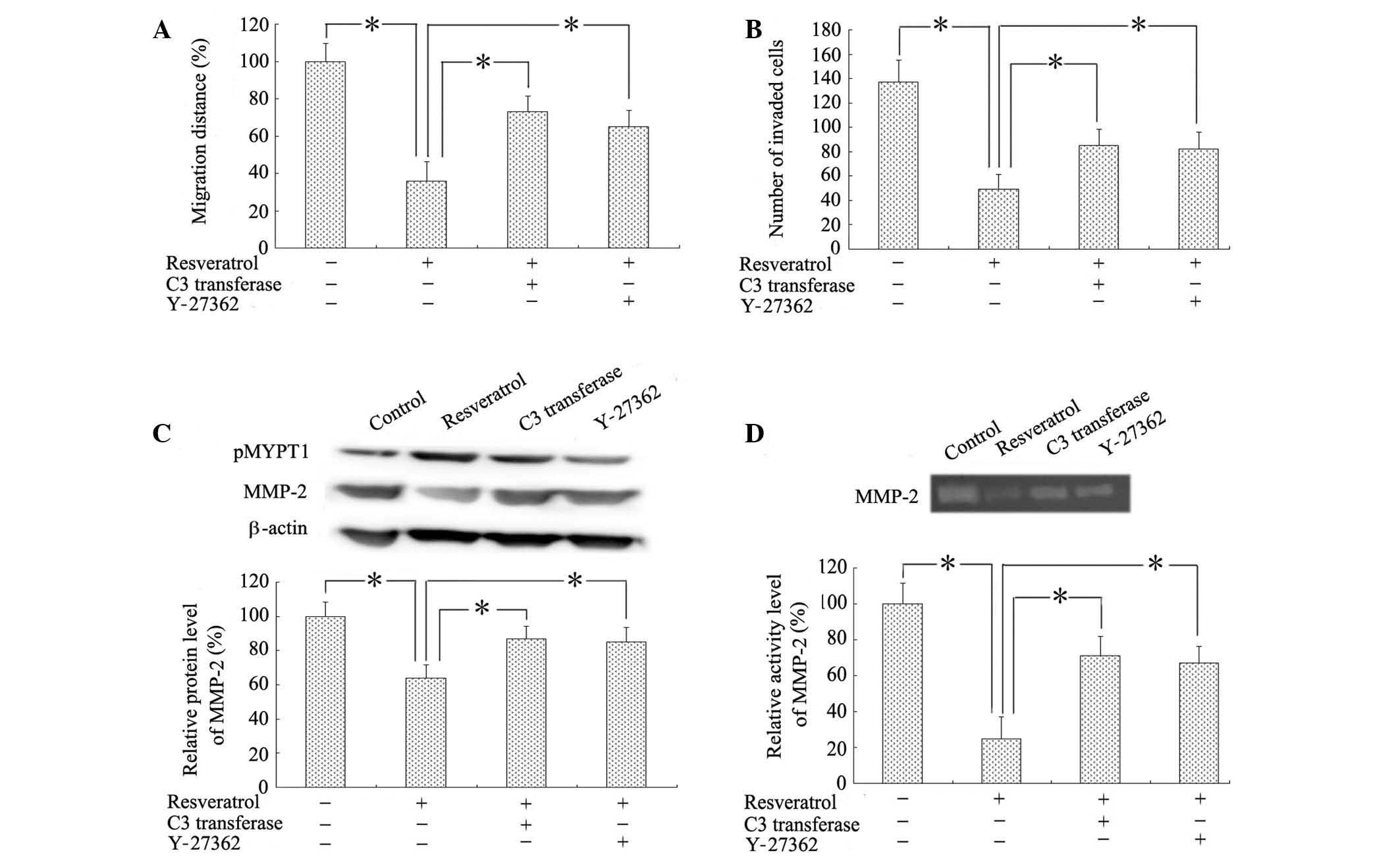Resveratrol suppresses human glioblastoma cell migration and invasion via activation of RhoA/ROCK signaling pathway
- Authors:
- Published online on: November 6, 2015 https://doi.org/10.3892/ol.2015.3888
- Pages: 484-490
Abstract
Introduction
Glioblastoma is the most common and lethal intracranial malignant tumor with a yearly incidence of 3–4 per 100,000 (1). Despite the use of multimodal treatments, the prognosis of glioblastoma has been little improved, with a typical median survival time of only 12–15 months (2). Due to the diffuse infiltration of glioblastoma cells into the brain tissues, resection of the bulk tumor is typically followed by tumor reinitiation at the resection site or at another location in the brain. The highly aggressive and invasive properties of glioblastoma cells contribute significantly to the poor prognosis of cases involving this type of tumor (3). Therefore, it has been proposed that anti-invasion agents may play a crucial role in the treatment of glioblastoma (4).
The invasion of malignant cancer cells is favored by degradation of the extracellular matrix (ECM), upregulation of proteolytic enzyme activity and an increase in tumor cell motility and invasive ability (5,6). Accumulating evidence has suggested that matrix metalloproteinases (MMPs) are capable of promoting tumor invasion and metastasis via degradation of the ECM (7), among which two gelatinases, MMP-2 and MMP-9, have attracted the most attention (8). Rho GTPases are a family of small GTP-binding proteins that serve as molecular switches in a wide variety of cellular signaling pathways, ultimately inducing changes in the organization of the actin cytoskeleton and regulating cell motility (9). It has been reported that RhoA activity is significantly reduced in astrocytic tumors (10–12), and increased RhoA activity in glioblastoma cells has been associated with impaired cell migration and invasion through the rearrangement of actin into stress fibers and the induction of focal adhesions (13).
Resveratrol is a natural polyphenol that exists in grapes, berries and peanuts (14). Previous studies reported that resveratrol was able to induce apoptosis and suppress proliferation in various cancer cell types (15,16). In addition, resveratrol has been demonstrated to inhibit cell proliferation and induce apoptosis in glioblastoma cells (17,18). However, the effects of resveratrol on the motility and invasiveness of glioblastoma cells is not well documented. Therefore, the current study aimed to examine the effects of resveratrol on cell migration and invasion in human glioblastoma cells, and to explore the underlying molecular mechanisms.
Materials and methods
Cell culture and chemicals
Human glioblastoma U87MG, T98G and U251 cells were obtained from the cell bank of the Fourth Military Medical University (Xi'an, China) and cultured in Dulbecco's modified Eagle's medium (DMEM; Sigma-Aldrich, St. Louis, MO, USA) supplemented with 10% fetal bovine serum (FBS; Shanghai BioSun Sci&Tech Co., Ltd., Shanghai, China) at 37°C in a humidified atmosphere of 5% CO2 and 95% air. Resveratrol (Santa Cruz Biotechnology, Inc., Santa Cruz, CA, USA) was dissolved in dimethyl sulfoxide (DMSO; Thermo Fisher Scientific, Grand Island, NY, USA) to produce a 100 mM stock solution, which was stored at −20°C. Prior to the experiments, fresh DMEM was used to dissolve resveratrol stock solution to working concentrations. C3 transferase (Cytoskeleton Inc., Denver, CO, USA) and Y-27362 (#sc-216067A; Santa Cruz Biotechnology, Inc.) were added directly to the media at concentrations of 0.25 µg/ml and 5 µg/ml, respectively, and cells were harvested or analyzed following treatment for 48 h. For each experiment, control groups were treated with fresh DMEM containing 0.1% DMSO.
The Upstate® Rho Activation Assay Kit (#17–294) was purchased from EMD Millipore (Lake Placid, NY, USA). Tris-HCl, bromophenol blue and Triton X-100 were purchased from Sigma-Aldrich. CaCl2, ZnCl2 and methanol were purchased from Tianjin Tianli Chemical Co., Ltd. (Tianjin, China).
Methyl thiazolyl tetrazolium (MTT) assay
The cytotoxicity of resveratrol was measured using an MTT assay (Sigma-Aldrich). U87MG, T98G and U251 cells were grown in 96-well plates (Greiner Bio-One GmbH, Frickenhausen, Germany) at a density of 5×104 cells/well and cultured for 24 h. Cells were then treated with resveratrol at various concentrations (20–100 µM). Following incubation for 48 h, 20 µl MTT (5 mg/ml) was added to each well and incubated at 37°C for 4 h. Finally, 150 µl DMSO was added to solubilize the formazan crystals, and the amount of formazan salt was determined by measuring the optical density (OD) at 490 nm using a Bio-Rad 680 microplate reader (Bio-Rad Laboratories, Inc., Hercules, CA, USA). Cell viability was expressed as the percent OD value of each group relative to that of control cells.
Wound-healing assay
Cells were seeded in 6-well culture plates (5×105 cells/well) and grown to 80–90% confluence. Monolayer cells were wounded by scratching the surface with a sterile 200-µl pipette tip to create a gap of constant width, and the cells were then incubated with serum-free DMEM. Following incubation for 12 h, the medium was aspirated and the cells were exposed to resveratrol treatment. The speed of wound healing was considered to represent the motile capacity of the cells. Wound closure was monitored and photographed at 0, 24 and 48 h by phase-contrast microscopy (TS100 microscope; Nikon Corporation, Tokyo, Japan). The gap widths were counted in five random fields.
Matrigel transwell assay
Cell invasion was determined with Matrigel-coated transwell cell culture chambers (8 µm pore size; EMD Millipore, Billerica, MA, USA). Cells were incubated for 12 h in serum-free medium, then trypsinized and resuspended in serum-free DMEM and placed in the upper chamber of the transwell insert (4×104 cells/well). Medium containing 10% FBS was applied to the lower chamber as a chemoattractant. After incubating the cells for 6 h, medium in the upper chamber was aspirated and replaced by resveratrol solution. The chamber was then incubated for 48 h at 37°C. At the end of the incubation, the invaded cells were fixed with methanol and stained with hematoxylin and eosin solution. The number of cells in five random fields were counted under a Nikon TS100 light microscope.
Gelatin zymography
Gelatin (#G9391; Sigma-Aldrich) was dissolved in distilled water at a concentration of 1%, autoclaved, cooled and stored at 4°C. Cells were incubated in serum-free DMEM for 48 h. The conditioned medium was collected and measured using a bicinchoninic acid assay (#P0012; Beyotime Institute of Biotechnology, Shanghai, China) to detect the protein concentration. Samples (21 µl) with equal protein concentrations were mixed with 7 µl sample buffer containing 0.32 M Tris base, 4% sodium dodecyl sulfate (SDS), 16% glycerin, and 0.1% bromphenol blue (pH 7.6), and loaded onto 8% SDS-polyacrylamide gels that had been copolymerized with 0.1% gelatin (SDS-PAGE gel preparation kit; #P0012A; Beyotime Institute of Biotechnology). Electrophoresis was performed at 4°C. The gels were then eluted in wash buffer (50 mM Tris-HCl, pH 7.6; 5 mM CaCl2; 2.5% Triton X-100)to remove SDS, rinsed in rinsing buffer (50 mM Tris-HCl, pH 7.6; 5 mM CaCl2) and then incubated in reaction buffer [50 mM Tris-HCl, pH 7.6; 5 mM CaCl2; 1 µM ZnCl2; 0.02% Brij-35 (Santa Cruz Biotechnology, Inc.)] at 37°C. The gel was stained with 0.05% Coomassie Blue (Beyotime Institute of Biotechnology) in 30% methanol/10% acetic acid for 3 h and de-stained in 30% methanol/10% acetic acid. The activity of gelatinases was observed as opaque unstained bands.
Western blot analysis
Western blot analysis was performed as previously described (18). In brief, equivalent amounts (25 µg) of protein lysates were loaded into each well, separated by 8% SDS-PAGE and transferred to nitrocellulose blotting membranes (0.22 µm; EMD Millipore). The membranes were probed with rabbit polyclonal antibodies against human MMP-2 (#BS1236; Bioworld Technology, Inc., St. Louis Park, MN, USA; dilution, 1:1,000), phosphorylated (p) myosin phosphatase target subunit 1 (MYPT1; #BS4114; Bioworld Technology, Inc.; dilution, 1:1,000) and β-actin (#sc-130656; Santa Cruz Biotechnology, Inc.; dilution, 1:2,000), followed by incubation for 1 h at room temperature with horseradish peroxidase-conjugated goat anti-rabbit IgG secondary antibody (#sc-2004; dilution, 1:5,000; Santa Cruz Biotechnology, Inc.). The membranes were then developed using an ECL system (Cell Signaling Technology, Beverly, MA, USA). The grayscale values of each band on the blots were measured using BandScan software version 4.3 (Glyko Biomedical Ltd., Novato, CA, USA); the integrated density of each band was normalized to the corresponding human β-actin band. Representative results from at least three independent experiments are shown.
Measurement of RhoA activity
RhoA activity was measured using a pull-down assay (Upstate® Rho Activation Assay Kit) according to the manufacturer instructions. Briefly, protein lysates and Rhotekin agarose were incubated for 45 min at 4°C with gentle agitation. Following thorough washes, the samples were boiled for 5 min in Laemmli buffer [60 mM Tris-HCl, pH 6.8; 2% SDS; 10% glycerin (Tianjin Yongda Chemical Reagent Co., Ltd., Tianjin City, China); 5% β-mercaptoethanol (Sigma–Aldrich); 0.1% bromphenol blue] to detach active GTP-bound Rho and loaded on SDS-PAGE gels and immunoblotted using the anti-RhoA antibody included with the assay kit. The subsequent procedure was performed as for the western blot analysis.
Statistical analysis
Data are presented as the mean ± standard deviation of three independent experiments, and were evaluated by one-way analysis of variance using SPSS software version 13.0 (SPSS, Inc., Chicago, IL, USA). P<0.05 was considered to indicate statistically significant differences.
Results
Resveratrol suppresses human glioblastoma cell migration and invasion in vitro
To rule out a cytotoxic effect on cell number following resveratrol treatment, the viability of U87MG, T98G and U251 cells treated with increasing concentrations of resveratrol (20–100 µM) for 48 h was assessed by MTT assay. Resveratrol inhibited the cell viability of glioblastoma cells in a concentration-dependent manner; however, it had only marginal effects on cell viability up to a concentration of 40 µM in all three cell lines (P>0.05; Fig. 1). However, treatment with 60 µM resveratrol demonstrated significant cytotoxic effects on the cell viability of U87MG and U251 cells (P<0.05; Fig. 1). Thus, the non-cytotoxic concentration of 40 µM resveratrol was used in the subsequent experiments. To evaluate the effects of resveratrol on cell migration and invasion, wound-healing and Matrigel transwell assays were performed, revealing that resveratrol significantly inhibited human glioblastoma cell migration and invasion in vitro. Specifically, resveratrol reduced the migration distance of U87MG cells to 33.5±6.5% relative to the control group (Fig. 2A; P<0.001), and decreased the number of U87MG cells invading through the matrigel by ~64% (Fig. 2B; P<0.001) following incubation for 48 h. Similar results were observed in T98G and U251 cells to a lesser degree (Fig. 2).
Resveratrol inhibits activity and expression of MMP-2 in glioblastoma cells
MMPs, particularly MMP-2, are reported to be crucial for cell migration and invasion in numerous types of tumor, including glioblastoma (19). Using western blot analysis, resveratrol was observed to induce a marked reduction in MMP-2 protein expression in all three glioblastoma cell lines (P<0.001; Fig. 3A). Furthermore, gelatin zymographic analyses were performed to determine the MMP-2 gelatinolytic activity. As indicated by Fig. 3B, the suppression of MMP-2 activity due to resveratrol was confirmed in the three cell lines, with a reduction to 20–40% relative to each control group (P<0.001).
Resveratrol increases activation of RhoA in glioblastoma cells
The Rho family GTPase RhoA has been implicated in the regulation of cell contraction and retraction forces that are required for cell migration and invasion (20). In the current study, the activity of RhoA in glioblastoma cells in response to resveratrol was examined using a pull-down assay. The results revealed that resveratrol significantly increased activity of RhoA in glioblastoma cells (P<0.001; Fig. 4A). Despite the variations of basal RhoA activity among the different glioblastoma cell lines, the increases in RhoA activity induced by resveratrol were 2- to 3-fold higher than the baselines. Furthermore, to confirm the activation of RhoA/Rho-associated kinase (ROCK) signaling by resveratrol, the phosphorylation of MYPT1, a downstream target of ROCK, was examined. The results revealed that resveratrol significantly induced MYPT1 phosphorylation in glioblastoma cells (P<0.001; Fig. 4B).
Blockade of the RhoA/ROCK pathway reverses the inhibition of migration and invasion in glioblastoma cells induced by resveratrol
As U87MG cells manifested more sensitive responses to resveratrol treatment, they were selected for use in the subsequent experiments. Wound-healing and Matrigel transwell assays were performed using U87MG cells in the presence of resveratrol alone or in combination with a specific cell-permeable RhoA inhibitor (C3 transferase; 0.25 µg/ml), or ROCK inhibitor (Y-27362; 5 µg/ml). Consistently with our previous data, resveratrol led to significant reductions in the rates of cell migration and invasion relative to that of untreated controls; cell migration was reduced to ~30% (P<0.001), whilst the number of matrigel-invaded cells was decreased to ~40% (P<0.001). By contrast, inhibition of either RhoA or ROCK attenuated the resveratrol-induced reductions in cell migration and invasion, partially restoring the rates of migration and invasion to that of untreated cells (Fig. 5A and B). Next, the ability of inhibition of RhoA/ROCK signaling to interfere with MMP-2 expression and activity was investigated. As expected, western blot and zymographic analyses revealed that blocking RhoA/ROCK signaling partially rescued the decreased expression and activity of MMP-2 induced by resveratrol (P<0.001; Fig. 5C and D).
Discussion
The highly diffuse infiltration of tumor cells typically prevents a successful local treatment for glioblastoma (21). The present study demonstrated the ability of resveratrol to reduce cell migration and invasion in human glioblastoma cells in vitro. Furthermore, the results indicated that activation of RhoA and inhibition of MMP-2 activity may be responsible for the inhibitory effects of resveratrol on cell migration and invasion in glioblastoma cell lines. Thus, this natural dietary compound may be a promising therapeutic agent for the treatment of glioblastoma. Resveratrol is a natural polyphenol that is synthesized by a wide range of plant species. Over the past decades, numerous studies have reported that resveratrol inhibits cell proliferation, induces apoptosis in various kinds of cancer cells in vitro, and retards the growth of implanted tumors in vivo (15,16,22–24). More recent evidence has indicated that resveratrol is able to sensitize cancers to chemotherapy with cisplatin and other conventional anticancer therapeutics (25). Our previous studies had demonstrated that resveratrol was able to inhibit cell proliferation in U87MG and T98G cells, and could also reverse temozolomide resistance by downregulation of O-6-methylguanine-DNA methyltransferase in T98G glioblastoma cells (18,26,27). The present study further indicated that resveratrol is able to inhibit cell migration and invasion in U87MG, U251 and T98G glioblastoma cells via activation of the RhoA/ROCK pathway.
Tumor cells achieve their invasive ability through the secretion and activation of proteolytic enzymes, including serine, metallo- and cysteine proteases, which can degrade ECM components and break down other natural barriers to tumor invasion (5,6). A number of reports have revealed that elevated expression of MMPs is closely associated with the invasion and aggressiveness of tumor cells, including glioblastoma (8,28,29). Certain MMPs have become promising therapeutic targets for the development of anticancer drugs (30,31). The current results indicated that resveratrol repressed the expression and secretion of MMP-2 in glioblastoma cells, and that cell invasive ability was markedly impaired following MMP-2 gene silencing (data not shown). In accordance with these results, Gagliano et al (32) demonstrated that resveratrol is able to decrease the expression of MMP-2 in primary cultured glioblastoma cells. Notably, MMP-2 is not the only tumor invasion mediator targeted by resveratrol. In our previous study, resveratrol repressed YKL-40 expression and inhibited U87MG cell invasion (26). Another study also demonstrated that resveratrol reduced U373MG human glioma cell invasion through decreasing plasminogen activator and its specific receptor expression (33); urokinase plasminogen activator (uPA) and the uPA receptor are important mediators of cell migration and invasion in various cell types (34).
Rho GTPases, which serve as binary switches that cycle between an active GTP-bound form and an inactive GDP-bound form, are a class of key regulators of the actin cytoskeleton (9). Rho GTPases also coordinate the regulation of other cellular activities, including gene transcription, cell morphological changes and migration (35). RhoA, a well-known member of the Rho protein family, has been reported to be significantly underexpressed in astrocytoma and inversely correlated with tumor malignancy (10). The increase of RhoA activity in glioblastoma cells is reportedly linked with impaired cell migration and invasion through the rearrangement of actin into stress fibers and the induction of focal adhesions (12,36). The role of RhoA is mediated through a major effector, ROCK, activation of which has been shown to inhibit migration and invasion of astrocytoma cells (37). In the current study, based on the observation that resveratrol activated RhoA in glioblastoma cells, and that blockade of the RhoA/ROCK pathway attenuated the resveratrol-induced inhibition of cell migration and invasion, we hypothesize that the inhibitory effect of resveratrol on migration and invasion in glioblastoma cells may be mediated through the RhoA/ROCK pathway. A similar finding was reported in human umbilical vein endothelial cells, in which resveratrol inhibited cell migration through a RhoA/ROCK-dependent mechanism (38). With regard to the effect of the RhoA/ROCK pathway on MMP-2, however, there have been controversial reports: Inhibition of RhoA/ROCK was observed to increase MMP-2 expression and activity in microvascular endothelial cells, whereas MMP-2 activity was decreased in osteosarcoma cells (39,40). The mechanisms underlying the regulation of MMPs by RhoA and the effect on cell migration and invasion require further investigation. Notably, in the present study, the inhibition of cell migration and invasion by resveratrol was only partially restored by blocking the RhoA/ROCK pathway, suggesting the existence of other signaling pathways associated with resveratrol in glioblastoma cells.
In summary, the present findings indicate that resveratrol may inhibit glioblastoma cell motility and invasiveness via downregulation of MMP-2 and activation of the RhoA/ROCK signaling pathway. These findings highlight resveratrol as a promising therapeutic agent for glioblastoma patients, and form a basis for further investigation of this natural dietary compound.
Acknowledgements
The authors would like to thank Miss Juan Li (Xijing Institute of Clinical Neuroscience, Xi'an, China) for her technical assistance. This study was supported by the Chinese National Natural Science Foundation, (grant no. 81471266).
Glossary
Abbreviations
Abbreviations:
|
ECM |
extracellular matrix |
|
MTT |
methyl thiazolyl tetrazolium |
|
MMP |
matrix metalloproteinase |
References
|
Taylor JW, Chi AS and Cahill DP: Tailored therapy in diffuse gliomas: Using molecular classifiers to optimize clinical management. Oncology (Williston Park). 27:504–514. 2013.PubMed/NCBI | |
|
Van Meir EG, Hadjipanayis CG, Norden AD, et al: Exciting new advances in neuro-oncology: The avenue to a cure for malignant glioma. CA Cancer J Clin. 60:166–193. 2010. View Article : Google Scholar : PubMed/NCBI | |
|
Alves TR, Lima FR, Kahn SA, et al: Glioblastoma cells: A heterogeneous and fatal tumor interacting with the parenchyma. Life Sci. 89:532–539. 2011. View Article : Google Scholar : PubMed/NCBI | |
|
Munson J, Bonner M, Fried L, et al: Identifying new small molecule anti-invasive compounds for glioma treatment. Cell Cycle. 12:2200–2209. 2013. View Article : Google Scholar : PubMed/NCBI | |
|
Westermarck J and Kähäri VM: Regulation of matrix metalloproteinase expression in tumor invasion. FASEB J. 13:781–792. 1999.PubMed/NCBI | |
|
Kleiner DE and Stetler-Stevenson WG: Matrix metalloproteinases and metastasis. Cancer Chemother Pharmacol. 43(Suppl): S42–S51. 1999. View Article : Google Scholar : PubMed/NCBI | |
|
Kessenbrock K, Plaks V and Werb Z: Matrix metalloproteinases: Regulators of the tumor microenvironment. Cell. 141:52–67. 2010. View Article : Google Scholar : PubMed/NCBI | |
|
Forsyth PA, Wong H, Lainq TD, et al: Gelatinase-A (MMP-2), gelatinase-B (MMP-9) and membrane type matrix metalloproteinase-1 (MT1-MMP) are involved in different aspects of the pathophysiology of malignant gliomas. Br J Cancer. 79:1828–1835. 1999. View Article : Google Scholar : PubMed/NCBI | |
|
Hall A: Rho GTPases and the actin cytoskeleton. Science. 279:509–514. 1998. View Article : Google Scholar : PubMed/NCBI | |
|
Nutt CL, Mani DR, Betensky RA, et al: Gene expression-based classification of malignant gliomas correlates better with survival than histological classification. Cancer Res. 63:1602–1607. 2003.PubMed/NCBI | |
|
Forget MA, Desrosiers RR, Del M, Moumdjian R, Shedid D, Berthelet F and Béliveau R: The expression of rho proteins decreases with human brain tumor progression: Potential tumor markers. Clin Exp Metastasis. 19:9–15. 2002. View Article : Google Scholar : PubMed/NCBI | |
|
Malchinkhuu E, Sato K, Maehama T, Mogi C, Tomura H, Ishiuchi S, Yoshimoto Y, Kurose H and Okajima F: S1P (2) receptors mediate inhibition of glioma cell migration through Rho signaling pathways independent of PTEN. Biochem Biophys Res Commun. 366:963–968. 2008. View Article : Google Scholar : PubMed/NCBI | |
|
Goldberg L and Kloog Y: A Ras inhibitor tilts the balance between Rac and Rho and blocks phosphatidylinositol 3-kinasedependent glioblastoma cell migration. Cancer Res. 66:11709–11717. 2006. View Article : Google Scholar : PubMed/NCBI | |
|
Jang M, Cai L, Udeani GO, Slowing KV, Thomas CF, Beecher CW, Fong HH, Farnsworth NR, Kinghorn AD, Mehta RG, et al: Cancer chemopreventive activity of resveratrol, a natural product derived from grapes. Science. 275:218–220. 1997. View Article : Google Scholar : PubMed/NCBI | |
|
Baur JA and Sinclair DA: Therapeutic potential of resveratrol: The in vivo evidence. Nat Rev Drug Discov. 5:493–506. 2006. View Article : Google Scholar : PubMed/NCBI | |
|
Brakenhielm E, Cao R and Cao Y: Suppression of angiogenesis, tumour growth and wound healing by resveratrol, a natural compound in red wine and grapes. FASEB J. 15:1798–1800. 2001.PubMed/NCBI | |
|
Zhang W, Fei Z, Zhen H, Zhang JN and Zhang X: Resveratrol inhibits cell growth and induces apoptosis of rat C6 glioma cells. J Neurooncol. 81:231–240. 2007. View Article : Google Scholar : PubMed/NCBI | |
|
Lin H, Xiong W, Zhang X, Liu B, Zhang W, Zhang Y, Cheng J and Huang H: Notch-1 activation-dependent p53 restoration contributes to resveratrol-induced apoptosis in glioblastoma cells. Oncol Rep. 26:925–930. 2011.PubMed/NCBI | |
|
Philip S, Bulbule A and Kundu GC: Matrix metalloproteinase-2: Mechanism and regulation of NF-kappaB-mediated activation and its role in cell motility and ECM-invasion. Glycoconj J. 21:429–441. 2004. View Article : Google Scholar : PubMed/NCBI | |
|
Matsuoka T, Yashiro M, Kato Y, Shinto O, Kashiwagi S and Hirakawa K: RhoA/ROCK signaling mediates plasticity of scirrhous gastric carcinoma motility. Clin Exp Metastasis. 28:627–636. 2011. View Article : Google Scholar : PubMed/NCBI | |
|
Giese A, Bjerkvig R, Berens ME and Westphal M: Cost of migration: invasion of malignant gliomas and implications for treatment. J Clin Oncol. 21:1624–1636. 2003. View Article : Google Scholar : PubMed/NCBI | |
|
Wu H, Liang X, Fang Y, Qin X, Zhang Y and Liu J: Resveratrol inhibits hypoxia-induced metastasis potential enhancement by restricting hypoxia-induced factor-1 alpha expression in colon carcinoma cells. Biomed Pharmacother. 62:613–621. 2008. View Article : Google Scholar : PubMed/NCBI | |
|
Kundu JK and Surh YJ: Cancer chemopreventive and therapeutic potential of resveratrol: Mechanistic perspectives. Cancer Lett. 269:243–261. 2008. View Article : Google Scholar : PubMed/NCBI | |
|
Rodrigue CM, Porteu F, Navarro N, Bruyneel E, Bracke M, Romeo PH, Gespach C and Garel MC: The cancer chemopreventive agent resveratrol induces tensin, a cell-matrix adhesion protein with signaling and antitumor activities. Oncogene. 24:3274–3284. 2005. View Article : Google Scholar : PubMed/NCBI | |
|
EI-Mowafy AM, EI-Mesery ME, Salem HA, Al-Gayyar MM and Darweish MM: Prominent chemopreventive and chemoenhancing effects for resveratrol: Unraveling molecular targets and the role of C-reactive protein. Chemotherapy. 56:60–65. 2010. View Article : Google Scholar : PubMed/NCBI | |
|
Zhang W, Murao K, Zhang X, Matsumoto K, Diah S, Okada M, Miyake K, Kawai N, Fei Z and Tamiya T: Resveratrol represses YKL-40 expression in human glioma U87 cells. BMC Cancer. 10:5932010. View Article : Google Scholar : PubMed/NCBI | |
|
Huang H, Lin H, Zhang X and Li J: Resveratrol reverses temozolomide resistance by downregulation of MGMT in T98G glioblastoma cells by the NF-κB-dependent pathway. Onclo Rep. 27:2050–2056. 2012. | |
|
Libra M, Scalisi A, Vella N, Clementi S, Sorio R, Stivala F, Spandidos DA and Mazzarino C: Uterine cervical carcinoma: Role of matrix metalloproteinases (review). Int J Oncol. 34:897–903. 2009. View Article : Google Scholar : PubMed/NCBI | |
|
Rao JS, Steck PA, Mohanam S, Stetler-Stevenson WG, Liotta LA and Sawaya R: Elevated levels of M(r) 92,000 type IV collagenase in human brain tumors. Cancer Res. 53(10 Suppl): 2208–2211. 1993.PubMed/NCBI | |
|
Gabelloni P, Da Pozzo E, Bendinelli S, Costa B, Nuti E, Casalini F, Orlandini E, Da Settimo F, Rossello A and Martini C: Inhibition of metalloproteinases derived from tumours: New insights in the treatment of human glioblastoma. Neurosci. 168:514–522. 2010. View Article : Google Scholar | |
|
Kim SY, Lee EJ, Woo MS, Jung JS, Hyun JW, Min SW, Kim DH and Kim HS: Inhibition of matrix metalloproteinase-9 gene expression by an isoflavone metabolite, irisolidone in U87MG human astroglioma cells. Biochem Biophys Res Commun. 366:493–499. 2008. View Article : Google Scholar : PubMed/NCBI | |
|
Gagliano N, Moscheni C, Torri C, Magnani I, Bertelli AA and Gioia M: Effect of resveratrol on matrix metalloproteinase-2 (MMP-2) and secreted protein acidic and rich in cysteine (SPARC) on human cultured glioblastoma cells. Biomed Pharmacother. 59:359–364. 2005. View Article : Google Scholar : PubMed/NCBI | |
|
Ryu J, Ku BM, Lee YK, Jeong JY, Kang S, Choi J, Yang Y, Lee DH, Roh GS, Kim HJ, et al: Resveratrol reduces TNF-α-induced U373MG human glioma cell invasion through regulating NF-κB activation and uPA/uPAR expression. Anticaner Res. 31:4223–4230. 2011. | |
|
Guo J, Fan KX, Xie L, Xiao JJ, Chen K, Hui LN and Xu ZH: Effect and prognostic significance of the KAI1 gene in human gastric carcinoma. Oncol Lett. 10:2035–2042. 2015.PubMed/NCBI | |
|
Nobes CD and Hall A: Rho, rac and cdc42 GTPases regulate the assembly of multimolecular focal complexes associated with actin stress fibers, lamellipodia and filopodia. Cell. 81:53–62. 1995. View Article : Google Scholar : PubMed/NCBI | |
|
Khalil BD, Hanna S, Saykali BA, El-Sitt S, Nasrallah A, Marston D, El-Sabban M, Hahn KM, Symons M and El-Sibai M: The regulation of RhoA at focal adhesions by StarD13 is important for astrocytoma cell motility. Exp Cell Res. 321:109–122. 2014. View Article : Google Scholar : PubMed/NCBI | |
|
Salhia B, Rutten F, Nakada M, Beaudry C, Berens M, Kwan A and Rutka JT: Inhibition of Rho-kinase affects astrocytoma morphology, motility and invasion through activation of Rac1. Cancer Res. 65:8792–8800. 2005. View Article : Google Scholar : PubMed/NCBI | |
|
Cicha I, Regler M, Urschel K, Goppelt-Struebe M, Daniel WG and Garlichs CD: Resveratrol inhibits monocytic cell chemotaxis to MCP-1 and prevents spontaneous endothelial cell migration through Rho kinase-dependent mechanism. J Atheroscler Thromb. 18:1031–1042. 2011. View Article : Google Scholar : PubMed/NCBI | |
|
Ispanovic E, Serio D and Haas TL: Cdc42 and RhoA have opposing roles in regulating membrane type 1-matrix metalloproteinase localization and matrix metalloproteinase-2 activation. Am J Physiol Cell Physiol. 295:C600–C610. 2008. View Article : Google Scholar : PubMed/NCBI | |
|
Fromigué O, Hamidouche Z and Marie PJ: Blockade of the RhoA-JNK-c-Jun-MMP2 cascade by atorvastatin reduces osteosarcoma cell invasion. J Biol Chem. 283:30549–30556. 2008. View Article : Google Scholar : PubMed/NCBI |



